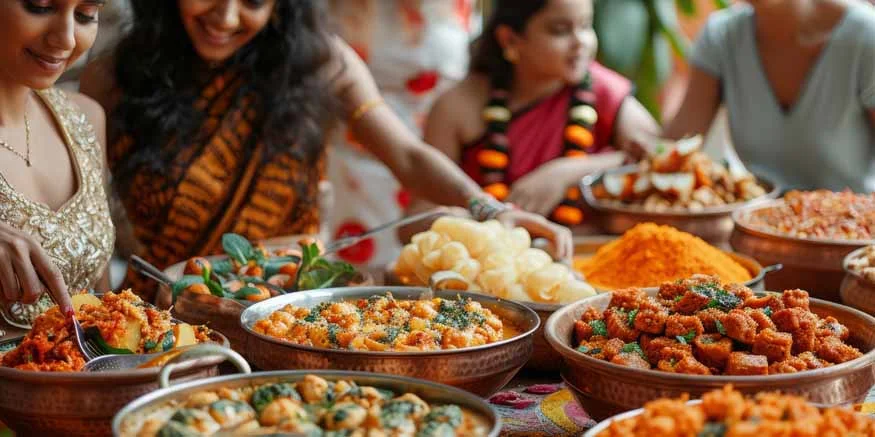In our interconnected world, diverse cultures come together through the careful preparation, driven eating, and profound appreciation of culinary masterpieces. Our goal is to provide an in-depth study of the fascinating subject of food cultures, highlighting the complex relationships they create and their significant impact on the way we live. Understanding different cultures and their food brings us closer and fosters greater awareness of many traditions and the importance of food in every dish and dining experience.
Also read: Explore Pune: Culture, Cuisine, Festivals, and Interesting Facts
What is Food Culture? – Definition
“Food culture” refers to the concepts, guidelines, and customs related to the preparation, production, and consumption of food within a particular culture or group. It encompasses the methods by which people grow, collect, prepare, and eat food, as well as the social, cultural, and environmental factors that influence these habits.
What are the Different Food Cultures?
- Indian Food Culture
- Chinese Food Culture
- European Food Culture
- Japanese Food Culture
- Middle Eastern Food Culture
- African Food Culture
- Latin American Food Culture
India’s diverse landscape, historical events, and traditions are reflected in its varied flavours, ingredients, and cooking methods. Each region has its unique eating habits. Indian food changes significantly by area, from the hearty Northern paratha dishes to the fiery Southern curries.
Chinese food culture has a rich history and reflects several regional styles. Techniques such as stir-frying, roasting, and steaming, along with fresh ingredients, celebrate flavour enhancement.
European cuisine includes the culinary traditions of countries like Germany, France, Italy, and Spain. Each has distinct flavours, ingredients, and preparation techniques influenced by historical and regional factors.
Japanese cuisine is known for specialties like sushi, sashimi, and ramen. The culture values attention to detail, ingredient accessibility, and elegant presentation in food preparation.
Middle Eastern cooking often uses ingredients like meat, rice, and chickpeas. Hummus, falafel, and kebabs are staples in the region’s culinary landscape.
Africa’s food culture is rich with unique ingredients, flavours, and cooking techniques. Each region highlights the continent’s deep cultural roots and food customs.
Latin American cuisine is a fusion of Central and South American culinary practices. Tacos, ceviche, and empanadas are made with beans, maize, chilli peppers, and tropical fruits.
Also read: Cultural Influences on Child Nutrition: Traditions and Local Diets
How Do Food and Culture Relate to Each Other?
Food and culture are closely related, reflecting the opinions, practices, beliefs, and personalities of a country or group of people. Food promotes unity within society, cultural expression, and the safeguarding of history. People shape and preserve their cultural identity through food, celebrating holidays and customs, connecting with their ancestors, and demonstrating kindness and generosity.
Understanding Different Food Cultures
- What Sets Different Food Cultures Apart?
- Diversity in Culinary Identity
Every culinary culture has diversity due to its unique approaches to food consumption, long-standing customs, and traditions. Each nation contributes distinct flavours and culinary expertise to the world’s culinary scene, whether through street food vendors or luxurious restaurants.
The world’s culinary identities are shaped by complex cooking methods, diverse ingredients, and a wide range of flavours. Each culture’s food identity tells a fascinating story about its people, history, and relationship to the land.
Relationships Forged Through Food
- The Social Power of Meals
- Food as a Cultural Bridge
Meals are invaluable for building connections that transcend language barriers. Shared meals create lasting memories and develop connections that go beyond spoken language, showcasing the richness of different cultures and their food.
Exploring the culinary customs of various societies provides valuable insights into the people who crafted the foods. This understanding encourages interaction between cultures and deepens appreciation for the diversity of global culinary traditions.
Also read: Guide to Teaching Kids to Cook
Importance of Food Culture in Different Regions of India
- A Culinary Odyssey Through India
- Regional Ingredients and Influences
- Events and Customs
Every Indian region offers a taste journey through diverse landscapes and civilizations with its culinary treasures. The country’s food culture is a vibrant representation of its diversity, from the spicy curries of the South to the hearty bread-centric meals of the North.
Every Indian region’s cuisine is profoundly influenced by its topography and historical legacy. Coastal areas are abundant in seafood, while arid regions inspire inventive uses of limited resources. Understanding regional differences in Indian food offers insight into the customs and history that have shaped the country’s culinary landscape.
Indian celebrations and customs intricately involve food. Special meals with cultural significance are prepared during occasions like Diwali and Holi. The preparation and sharing of food, deeply rooted in the nation’s history, give these occasions greater cultural importance.
Exploring Culinary Traditions Around the World
The world’s diverse culinary traditions reflect different cultures and their food. Each cuisine tells a unique story shaped by location, climate, agriculture, trade, and cultural exchange. Investigating these food customs fosters respect and understanding across cultural boundaries, teaching us to appreciate the range and depth of the world’s food practices.
At EuroSchool, we understand the intricate details, connections, and significance of the many culinary traditions that shape our unique perspectives. In addition to tasting various flavours, we impart a deep understanding of international cooking customs. Recognizing the importance of promoting cultural sensitivity, EuroSchool embraces cuisine as a common language. For more such interesting blogs, visit EuroSchool.









